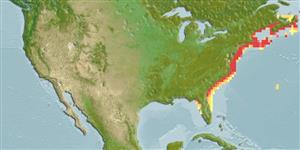>
Clupeiformes (Herrings) >
Alosidae (Shads and Sardines)
Etymology: Alosa: Latin, alausa = a fish cited by Ausonius and Latin, halec = pickle, dealing with the Greek word hals = salt; it is also the old Saxon name for shad = "alli" ; 1591 (Ref. 45335).
More on author: Mitchill.
Environment: milieu / climate zone / depth range / distribution range
पारिस्थितिकी
समुद्री; स्वच्छ जल, अलवण जल; खारा; ऐनाढरोमस (Ref. 51243); गहराई सीमा 5 - 55 m (Ref. 5951). Subtropical; 47°N - 27°N, 84°W - 60°W (Ref. 117456)
Western Atlantic: Cape Breton, Nova Scotia south to the St. John's River, Florida; also in lower parts of rivers (Ref. 188). Introduced in reservoirs in several states, and in the upper Tennessee River system in Tennessee, USA (Ref. 117456, 86798).
आकार / वज़न / Age
Maturity: Lm ? range ? - ? cm
Max length : 40.0 cm SL पुल्लिंग / अलिंग; (Ref. 7251); common length : 27.5 cm SL पुल्लिंग / अलिंग; (Ref. 188); अधिकतम प्रकाशित वज़न: 200.00 g (Ref. 7251); अधिकतम सूचित उम्र: 8 वर्षो (Ref. 12193)
पृष्ठीय रीढ़ (सम्पूर्ण): 0; पृष्ठीय सौफट रेज़ (सम्पूर्ण): 15-20; गुदा कांटा 0; ऐनल सौफट रेज़: 15 - 21; जानवरों की रीड़ का जोड़: 47 - 53. Moderately compressed, belly with distinct keel of scutes. Upper jaw with a distinct notch; lower jaw rising steeply within mouth; minute teeth present at front of jaws (disappearing with age). Lower gill rakers 41 to 52 (fewer in fishes under 10 cm standard length), slender. Back dark blue, sometimes bluish-grey; a dark spot on shoulder (Ref. 188). Peritoneum black (Ref. 7251). Branchiostegal rays 7 (Ref. 4639).
Inhabits rivers, estuaries, coastal waters, lakes and reservoirs (Ref. 117456). Adults are found in saltwater except during the spawning season and occur up to at least 200 km offshore (Ref. 117456). Forms schools and possibly wintering near the bottom and out from the coast, approaching the shore in the late spring. Feeds on small fishes, copepods and small shrimps. Spawns in brackish- or freshwaters of rivers, arriving in coastal waters a month or so later than A. pseudoharengus (in April at Chesapeake Bay, apparently when the water is above 7.0° C and later further north). Eggs are essentially pelagic, demersal in still water (Ref. 4639). Larvae are found in fresh and brackish rivers (Ref. 4639). Juveniles leave fresh and brackish nursery grounds at about 5 cm, migrating downstream (Ref. 4639). In freshwater habitat, this species usually occurs in current over rocky bottom (Ref. 86798). Marketed mostly fresh and salted (Ref. 188). Parasites found are acanthocephalan and nematodes (Ref. 37032).
Upriver movement to spawning areas occur in late afternoon or at night (Ref. 4639).
Whitehead, P.J.P., 1985. FAO Species Catalogue. Vol. 7. Clupeoid fishes of the world (suborder Clupeoidei). An annotated and illustrated catalogue of the herrings, sardines, pilchards, sprats, shads, anchovies and wolf-herrings. FAO Fish. Synop. 125(7/1):1-303. Rome: FAO. (Ref. 188)
IUCN Red List Status (Ref. 130435)
Threat to humans
Harmless
Human uses
मात्स्यिकी: व्यापारिक
अधिक जानकारी
संदर्भजलीयकृषिजलीयकृषि रूपरेखाखींचआनुवंशिकीElectrophoresesहैरेटिबिलटीबीमारीप्रक्रमणNutrientsMass conversion
साधन
Special reports
Download XML
इंटरनेट स्रोत
Estimates based on models
Preferred temperature (Ref.
123201): 11.5 - 24.7, mean 23.7 °C (based on 86 cells).
Phylogenetic diversity index (Ref.
82804): PD
50 = 0.5000 [Uniqueness, from 0.5 = low to 2.0 = high].
Bayesian length-weight: a=0.00794 (0.00370 - 0.01703), b=3.04 (2.87 - 3.21), in cm total length, based on LWR estimates for this Genus-body shape (Ref.
93245).
Trophic level (Ref.
69278): 3.8 ±0.3 se; based on diet studies.
लौटाव (Ref.
120179): माध्यम, न्यूनतम जनसंख्या दुगनी होने का समय 1.4 - 4.4 वर्ष। (K=0.18; tm=4; Fec=45,800).
Fishing Vulnerability (Ref.
59153): Moderate vulnerability (39 of 100).
Climate Vulnerability (Ref.
125649): Moderate to high vulnerability (50 of 100).
Nutrients (Ref.
124155): Calcium = 28.1 [13.7, 137.6] mg/100g; Iron = 1.47 [0.63, 3.85] mg/100g; Protein = 19.8 [17.4, 22.6] %; Omega3 = 0.744 [0.386, 1.503] g/100g; Selenium = 18 [9, 36] μg/100g; VitaminA = 18.7 [4.7, 78.7] μg/100g; Zinc = 0.505 [0.325, 0.920] mg/100g (wet weight);
